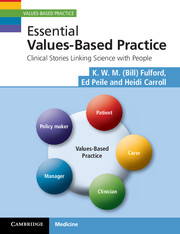Book contents
- Frontmatter
- Review quotes
- Contents
- Foreword
- Acknowledgements
- A bold claim to start this book
- Prologue: linking science with people
- Part 1 Values, individuals and an overview of values-based practice
- Part 2 The clinical skills for values-based practice
- Part 3 Relationships in values-based practice
- Part 4 Science and values-based practice
- Part 5 Bringing it all together
- Postcript: the small change of care
- A bold claim to end this book
- Appendix A Values-based practice summary and definitions of key terms
- Appendix B Values-based practice teaching framework
- Index
Part 4 - Science and values-based practice
Published online by Cambridge University Press: 05 June 2012
- Frontmatter
- Review quotes
- Contents
- Foreword
- Acknowledgements
- A bold claim to start this book
- Prologue: linking science with people
- Part 1 Values, individuals and an overview of values-based practice
- Part 2 The clinical skills for values-based practice
- Part 3 Relationships in values-based practice
- Part 4 Science and values-based practice
- Part 5 Bringing it all together
- Postcript: the small change of care
- A bold claim to end this book
- Appendix A Values-based practice summary and definitions of key terms
- Appendix B Values-based practice teaching framework
- Index
Summary
Introduction to Part 4
Values-based practice, as we have emphasized, is very much a partner to evidence-based practice as a support tool for clinical decision-making. The stories in earlier chapters all illustrate the close connections between values and evidence in clinical care and related areas of training and research.
So close indeed is the relationship between them that values and evidence may each in different ways sometimes come to mask or eclipse the other, with adverse consequences for practice. The three chapters in this part of the book illustrate three distinct ways in which this may happen and the importance of maintaining a balanced approach that keeps both values and evidence always equally in view:
• In Chapter 10, the Two-feet Principle underlines the point made in Chapter 1 that in medicine all decisions are both values and evidence driven. All decisions, then, in the terms of this principle stand on the two feet, respectively, of values and of evidence. In practice, however, where a decision is strongly evidence-based, important values may get overlooked – we may become, as this chapter will show, “values blinded by the evidence.”
This is what happened to Dr. Jane Hilary, the GP in this chapter, in her management of a middle-aged man, Jim Burns, with essential hypertension. So focused was Dr. Hilary on the evidence guiding her management that she failed to recognize the crucial impact of her own and Jim Burns' values.
- Type
- Chapter
- Information
- Essential Values-Based PracticeClinical Stories Linking Science with People, pp. 131 - 132Publisher: Cambridge University PressPrint publication year: 2012



